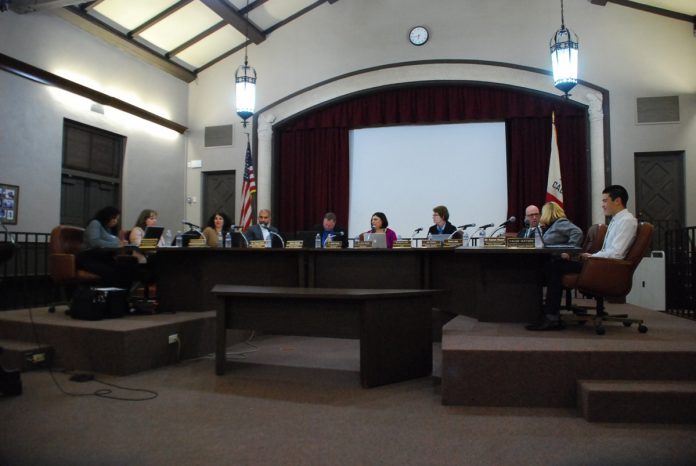Eying formal presentations with the city in coming weeks, South Pasadena Unified School Board Superintendent Geoff Yantz on Tuesday unveiled a draft set of objectives for board members to consider in connection with any deal to swap the District’s headquarter property at 1020 El Centro with a prospective developer.
The District would swap the property for an existing or newly developed site, opening opportunities without having to spend new money to renovate its century-old headquarters, which features an enormous parking lot that anchors the notorious “missing tooth” of the city’s Mission Street Specific Plan. A 2015 study put the cost of bringing the administrative building to code at $600,000.
The six objectives discussed at Tuesday’s SPUSD meeting should serve as “framework for how we want to move forward on this property,” Yantz said, noting they’d been developed over the last few months in meetings with city officials. He emphasized more input would be sought during joint presentations with the city manager at up-coming city council and school board meetings, and during additional community-wide sessions.
While board members have seen the draft objectives “individually,” Yantz wanted the board to review them collectively as they are not final, may conflict, and be subject to varying interpretations. And as they may not all be achievable, prioritization may be needed, he added.
Most board member comments focused on objective 3: “to promote economic, social and cultural vitality in the Mission Street corridor consistent” with the Mission Street Specific Plan.
“This point can be interpreted in different ways,” Yantz said, as “is not necessarily our primary mission.” But members suggested changes to emphasize the importance the Board places on tending its relationship with the city and the broader community.
Board member Jon Primuth said it is “critical the project provide a benefit to the city,” not least because citizens have twice in the last four years approved new taxes to provide the District with facility and operating funds. “Having a site that has all the wonderful promise of being part of a vital little village downtown” is important. “We need to make sure we honor and bring out that potential as much as we can.”
Objective 2 is to reallocate the $3.7 million remaining from the $6 million in Measure SP bond funding that was previously designated for district office renovation to other school site bond projects. The remaining $2.3 million was diverted to pay higher costs associated with the new STEM building, the dedication of which is set for April 24. Yantz said the $3.7 million could be freed up if the District is able to “capitalize” on the swap through revenue from a new development.
“The last time we went through this process, it was going to bring in $600,000 to $1,000,000 of revenue” but, he said vaguely, “there were different objectives around that deal.”
The District’s hope to leverage the swap to bring in new revenue is the basis for Objective 5, which is to “sustain or generate on-going revenue to support the long term financial needs of the District.” Yantz said the District “may not be able to accomplish this,” but noted that “a different type of project may bring in different benefits, rather than just straight revenue.”
Other objectives were “to have a safe, energy efficient and functional administrative office and training facility with 21st century features to house all current SPUSD administrative and South Pasadena Educational Foundation functions” and “to restore and preserve the [city’s] historic building and architectural heritage.”
The final objective is “to provide physical space for educationally-related support programs.” This is in case the swap results in more square-footage that the district can “grow into,” Yantz explained. “It could house educational programs that are not appropriate to have on a school site, but would offer a lot more opportunity.” Board members suggested the language be amended to more clearly specify the types of programs envisioned, such as adult training or other administrative functions.
Yantz said the final version of the objectives would be included in the joint presentations at next month’s board meeting and in a coming city council session.















.png)







